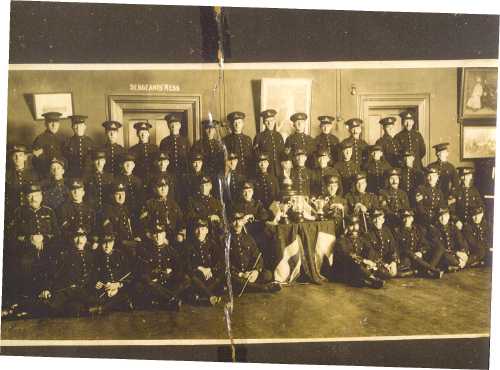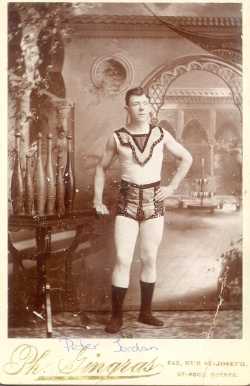Sign up for the Family Tree Newsletter Plus, you’ll receive our 10 Essential Genealogy Research Forms PDF as a special thank you!
Get Your Free Genealogy Forms
"*" indicates required fields
 |
 |
| Figure 1 | Figure 2 |
As a genealogist you spend time trying to fit together the pieces of a person’s life by locating vital records, evidence of activities and whatever else you can find. You hope to create a biography of that ancestor—part of the larger history of your family. Printed and written documents are important to tell that story, but there is nothing like a photograph to bring the information to life. Patricia Greber accumulated material on Peter Jordan, her great-grandfather, including a few photographs. One is a large group portrait and she wants to know how to pick him out of the crowd.
Peter Jordan led an interesting life as reflected in these two images. Born in 1878 in Quebec City, he was the son of Anne Ready and William Robert Jordan. During World War I, he enlisted at 38 years old in the First Depot Battalion, First Quebec Regiment, and was discharged in 1920. (If you want to learn more about Canada’s participation in World War I consult the Canadian Military Heritage Project at www.rootsweb.com/~canmil/index.html.) As a soldier, he never saw overseas military combat due to medical issues. His son recalls his father telling a story about visiting the Sergeant’s Mess for pie. This picture was taken on one of those visits. The health conditions that kept him from combat were not an issue earlier in his life. He was well known as a snow-shoeing champion, boxer and a juggler (figure 2).
Identifying a single face in a group portrait is easy if the person has a distinctive appearance. But what can you do if all the men in the picture blur together because of identical clothing such as the soldiers in Patricia’s photograph? Plenty.
First sharpen your powers of observation. Take out all of the pictures you have of the individual in question and lay them out in a timeline. Can you see where the group portrait fits? In Patricia’s case, her group picture and the other single portrait appear to be taken within a few years of each other. This is good news. As a person ages, his face changes due to illness or aging, and that can make identifying him as a young person difficult. Having several portraits taken around the time of the group picture increases your odds of successfully locating your ancestor.
Using a magnifying glass, examine each feature of your ancestor’s face. Pay particular attention to the shape of the ears, nose and spacing between the eyes. Any familial characteristics like overly large ears, a prominent brow and markings such as a scar can help you find the right person. Basically, you are looking for identifying details that don’t change even with a weight gain/loss or aging. In the single portrait of Peter Jordan, it is apparent that his ears tip away from his head at a slight angle and that he has thin lips. It is important to note that according to his family, Peter stood 5 feet 5 inches tall with blue eyes and brown hair. Blue eyes stand out in black and white photographs as pale eyes. His stature meant that a photographer would pose him either standing on a bench behind taller men or in the front.
By comparing the two pictures it is possible to find men that don’t fit the criteria. After eliminating all the brown-eyed men in the picture and those with features different from Peter’s, it is easier to find the correct person. I think that Peter Jordan stands third from the left in the back row near the door frame. He has the right ears, light eyes and a familiar nose. What do you think?
Apply these techniques to your group portraits and you might be surprised to discover another bit of photographic history for an ancestor. Depending on the image, you might even uncover a new lead for further research, or in Patricia Greber’s case, document a family story.
Find out how to submit your own picture for possible analysis by Maureen Taylor. E-mail her at mtaylor@taylorandstrong.com.
ADVERTISEMENT

